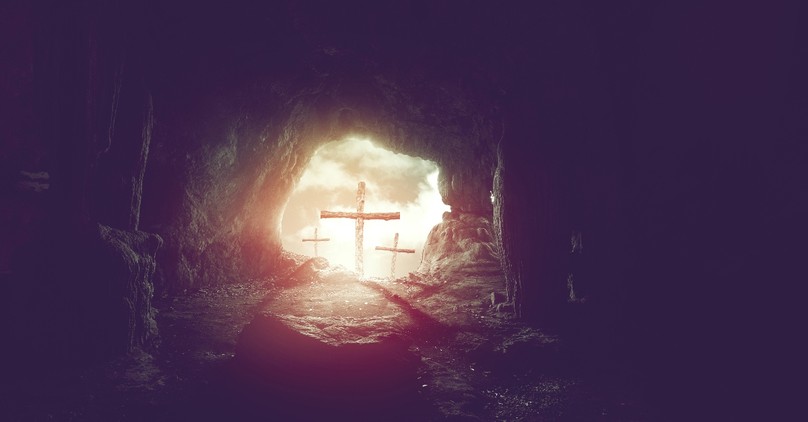
From February to April, people worldwide look forward to the blossoming of spring, fresh air, and flowers in bloom. They are aware that something brighter, warmer, and hopeful is coming at the end of a blistering, never-ending winter. I suppose that our history's apostles and age-old ancestors would say the same about hope in traumatic circumstances, but not about the weather.
After Jesus Christ was crucified horrifically on a cross, He was placed in a tomb from which He would rise three days later. Though many lacked the faith to believe this, He was a miracle-walker, walking from the grave and beyond as He said He would.
As Christians, some of us quickly assume that Jesus Christ was born, died, and resurrected so that we, too, can someday be resurrected from death. After all, Paul reminds us in 1 Corinthians 15 that if we don't believe that Christ was resurrected, our faith is forfeit. However, others, and many skeptics, have difficulty believing this truth in the face of what we know about Jesus' tomb.
So, what do we do when we have these questions? We face them head-on as we approach Scripture, the Gospels, and the throne with our heads bowed low.
Get your FREE Holy Week Guide here. Have encouragement delivered straight to your inbox!
Why Is Jesus' Tomb Empty?
The Resurrection According to Matthew
In the Book of Matthew, Mary Magdalene and the other Mary went to see Jesus' tomb after the Sabbath, toward the dawn of the first day of the week. I imagine the sun peeking over the clouds as they raced to the entrance of the tomb. As they meet an angel face-to-face, an earthquake suddenly matches the shaking inside their souls. In the presence of holiness, we know that the angel of the Lord "descended from Heaven and came and rolled back the stone and sat on it" (Matthew 28:2, ESV).
After this encounter, little is said about the tomb. However, we know that the women went from that place to spread the gospel without fear but a ferocious desire.
Matthew 28:1-10 describes the scene:
"Now after the Sabbath, toward the dawn of the first day of the week, Mary Magdalene and the other Mary went to see the tomb. And behold, there was a great earthquake, for an angel of the Lord descended from heaven and came and rolled back the stone and sat on it. His appearance was like lightning, and his clothing white as snow. And for fear of him the guards trembled and became like dead men. But the angel said to the women, "Do not be afraid, for I know that you seek Jesus who was crucified. He is not here, for he has risen. …” (Read the full passage in Matthew 28:1-10, ESV)
A few chapters prior, Matthew 27:62-66 gives us the context that a guard was stationed outside the tomb the day after Jesus' burial. This provides the reliability that the miracle would have happened from the inside out or when the guard was not on duty. While the other Gospels do not mention a guard, Mark and Luke also do not anticipate the women finding guards at their arrival.
Though many point to these inconsistencies as contradictory to Jesus' tomb, we can rest assured that the Bible's Author gave an account to the first-hand witnesses that recorded His story's details. As with every story, there are many angles, but each one beautifully combines to present a significant debut picture.
Photo Credit: ©iStock/Getty Images Plus/thanasus

The Resurrection According to Mark
Similar to the Gospel of Matthew, the Gospel of Mark mentions an angel of the Lord. However, when it comes to seeing the stone rolled away, it appears that when Mary Magdalene, Mary the mother of James, and Salome took spices to the tomb, Mark recounts that the grave was already open.
Mark 16:1-8 tells the story:
"Saturday evening, when the Sabbath ended, Mary Magdalene, Mary the mother of James, and Salome went out and purchased burial spices so they could anoint Jesus' body. Very early on Sunday morning, just at sunrise, they went to the tomb. On the way they were asking each other, "Who will roll away the stone for us from the entrance to the tomb?" But as they arrived, they looked up and saw that the stone, which was very large, had already been rolled aside. When they entered the tomb, they saw a young man clothed in a white robe sitting on the right side. …” (Read the full passage in Mark 16:1-8, ESV)
From these details, Mark 10:34 says that Jesus will rise again from this tomb after three days while Matthew 12:40 notes He will be in the earth three days and three nights. Luke and John do not comment on this amount of time, though all four books discuss anointing or wrapping the body after the tomb has been opened.
The Resurrection According to Luke
The third Gospel book, Luke again mentions women visiting a tomb where the stone has already been rolled away. In fact, Mark 16:4, Luke 24:2, and John 20:1 record this, while Matthew 28:1-2 notes that the stone would be rolled out later.
Similarly, while women are mentioned in all four books, whether they entered this tomb or not differs.
In Mark 16:5, the women enter and meet an angel, but in Matthew 28:2, they experience an earthquake and watch the angel roll away the stone in the presence of Pilate's guards. Luke 24:2-4 adds that once the women enter the tomb, two men or angels appear, but John 20:12 notes that they do not join when they see two angels sitting inside the tomb.
In the full summary of this resurrection, Luke 24:1-12 says:
"On the first day of the week, very early in the morning, the women took the spices they had prepared and went to the tomb. They found the stone rolled away from the tomb, but when they entered, they did not find the body of the Lord Jesus. While they were wondering about this, suddenly two men in clothes that gleamed like lightning stood beside them. In their fright the women bowed down with their faces to the ground, but the men said to them, "Why do you look for the living among the dead? He is not here; he has risen! …” (Read the full passage in Luke 24:1-12, ESV)
The Resurrection According to John
Like the other three Gospels present, Mary Magdalene came to the tomb on the first day of the week. However, at the entrance, she found the stone rolled away and immediately ran to ask Simon Peter where they put her Lord's body. While John does not mention much about the tomb itself, the context provides excellent evidence of its existence.
John 20:1-10 presents specific details before Jesus' appearance to others after His resurrection:
"Early on Sunday morning, while it was still dark, Mary Magdalene came to the tomb and found that the stone had been rolled away from the entrance. She ran and found Simon Peter and the other disciple, the one whom Jesus loved. She said, "They have taken the Lord's body out of the tomb, and we don't know where they have put him!" Peter and the other disciple started out for the tomb. They were both running, but the other disciple outran Peter and reached the tomb first. He stooped and looked in and saw the linen wrappings lying there, but he didn't go in. Then Simon Peter arrived and went inside. He also noticed the linen wrappings lying there, while the cloth that had covered Jesus' head was folded up and lying apart from the other wrappings. …” (Read the full passage in John 20:1-10, ESV)
Photo Credit: © Getty Images/Boonyachoat

What Do the Differences in These Gospel's Mean? Should We Be Concerned?
According to Peter Carnley's The Structure of Resurrection Belief, "There is no suggestion that the tomb was discovered by different witnesses on four different occasions, so it is, in fact, impossible to argue that the discrepancies were introduced by different witnesses of the one event; rather, they can be explained as four different redactions for apologetic and kerygmatic reasons of a single story originating from one source.”
Though there are four accounts, they recount one reality: Jesus Christ was born, crucified, buried, and raised so that we may have eternal life in victory with Him. As Christians, we should not be concerned by these matters but reaffirmed by this message's truth and the power it presents. Questions should only point us to the source of life and encourage striving to learn about our Creator's glorious miracle.
Do We Know Where Jesus’ Tomb Is Today?
According to Kristin Romey of National Geographic, for 60 hours, researchers had the opportunity to examine the tomb thought to be Jesus' tomb. Consisting of a limestone shell and marble cladding, on October 28th, 2016, archeologists uncovered the original limestone burial bed intact. As it appears that the tomb's location has not shifted from Jerusalem, this study also confirmed original limestone on the walls of the 19th-century shrine.
Noted by Romey, "While it is archaeologically impossible to say that the tomb recently uncovered in the Church of the Holy Sepulchre is the burial site of an individual Jew known as Jesus of Nazareth, there is indirect evidence to suggest that the identification of the site by representatives of the Roman emperor Constantine some 300 years later may be a reasonable one.”
As shared above, the cannon Gospels represent accurate details, which scholars and archeologists use today in furthering said study—details such as the tomb belonging to Joseph of Arimathea, a wealthy Jewish follower of Jesus. Because these four books come from the New Testament, it is explained that they were written by the disciples decades after Christ's death in A.D. 30.
While more than a thousand rock-cut tombs like this have been found in Jerusalem under investigation, the Holy Sepulcher Church's site provides the most substantially proven location. Other stipulations include the Talpiot Family Tomb, found in 1980 and located 5km south of the Old City of Jerusalem, and the Garden Tomb situated in 1883 by Charles Gordon.
Where Is Jesus' Tomb, and Why Is it so Crucial to Christianity?
The Significance of the Empty Tomb
It is evident that much research is said to be completed regarding the tomb of Jesus of Narazeth and that its current compilations can be overwhelming. However, I find it crucial that our focus is not on the number of traceable details shared but on what this tomb's presence means for us today.
Today, we can acknowledge that we still have questions and are digging for answers. It is okay to wrestle with these Canonical Gospels, do our research, and ask God “why.” But never allow those thoughts to detour your mind from the simplistic beauty of what this empty tomb means for you and me today.
In 1 Corinthians 15: 12-23, Paul writes,
"But if it is preached that Christ has been raised from the dead, how can some of you say that there is no resurrection of the dead? If there is no resurrection of the dead, then not even Christ has been raised. And if Christ has not been raised, our preaching is useless and so is your faith. More than that, we are then found to be false witnesses about God, for we have testified about God that he raised Christ from the dead. …" (Read the full passage in 1 Corinthians 15:12-23, ESV).
In all of our uncertainty, doubts, confusion, and questions, let us not grow weary of believing a message that saves our souls. Because of the empty grave, we have an eternal home to look forward to that extends far beyond any house we live in now. One day, Jesus will tell us all about the tomb He rose from down to the details of what it was made of, where it was located, and how it baffled centurions for hundreds of decades.
Sources:
The Structure of Resurrection Belief
Unsealing of Christ's Reputed Tomb Turns Up New Revelations
Contradictions in Gospel Accounts of Jesus' Tomb
Three Tombs of Jesus: Which is the Real One?
Photo Credit: © Getty Images/jgroup

Want more interaction with the women of iBelieve? Join our fans, writers, and editors at the iBelieve Facebook group, Together in Faith, for more videos, stories, testimonies, prayers and more. Visit here to join the community!


